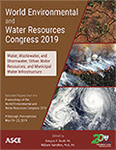World Environmental and Water Resources Congress 2019
Evaluating the Effectiveness of Bioswales and Catch Basin Inserts for Treating Urban Stormwater Runoff in Detroit, Michigan
Publication: World Environmental and Water Resources Congress 2019: Water, Wastewater, and Stormwater; Urban Water Resources; and Municipal Water Infrastructure
ABSTRACT
Bioswales and catch basin inserts are two current “buzz words” in the field of the environmental engineering. Bioswales are a “U” or “V” shaped depression in the landscape designed to: (1) reduce stormwater runoff volumes by increasing infiltration rates and (2) improve water quality by capturing sediment and sorbing contaminants. Catch basin inserts are runoff-filters with a sediment trap and various sorption media filters installed under an individual sewer grate with the goal of filtering particles and dissolved pollutants (both organic and inorganic) from stormwater before entering a sewer system. Both of these techniques improve the quality of stormwater runoff and these techniques have independently shown the potential to be effective. However, efficiencies of the processes are reduced in some situations due to poor management practices or insufficient design criteria. We first collected runoff samples from various locations around Detroit, MI, near the Wayne State University campus (parking lot runoff entering bioswales, street runoff entering storm sewers, etc.) to quantify appropriate concentrations of pollutants to use in our testing. We then tested various sorbent materials from commercial catch basin inserts and other promising sorbents (e.g., bonechar) with synthetic urban runoff to quantify the potential pollutant removal using inserts. Various amounts of sorbents were added to synthetic runoff solutions in 50 mL centrifuge tubes and measured for metal concentrations over time. We also evaluated some potential design flaws in bioswales and catch basin inserts and provided some recommendations to improve the efficiency of the processes and update best management practices.
Get full access to this article
View all available purchase options and get full access to this chapter.
References
Barrett, M. E., Irish, L. B. Jr, Malina, J. F. Jr, & Charbeneau, R. J. (1998). Characterization of highway runoff in Austin, Texas, area. Journal of Environmental Engineering, 124(2), 131-137.
Barrett, M. E., Irish, L. B. Jr, Malina, J. F. Jr, & Charbeneau, R. J. (1998). Characterization of highway runoff in Austin, Texas, area. Journal of Environmental Engineering, 124(2), 131-137.
Choe, J. S., Bang, K. W., & Lee, J. H. (2002). Characterization of surface runoff in urban areas. Water Science and Technology, 45(9), 249-254.
HUANG, J. L., DU, P. F., AO, C. T., LEI, M. H., ZHAO, D. Q., HO, M. H., & WANG, Z. S. (2007). Characterization of surface runoff from a subtropics urban catchment. Journal of Environmental Sciences, 19(2), 148-152.
Lee, J. H., & Bang, K. W. (2000). Characterization of urban stormwater runoff. Water research, 34(6), 1773-1780.
Smullen, J. T., Shallcross, A. L., & Cave, K. A. (1999). Updating the US nationwide urban runoff quality data base. Water Science and Technology, 39(12), 9-16.
Kayhanian, M., Suverkropp, C., Ruby, A., & Tsay, K. (2007). Characterization and prediction of highway runoff constituent event mean concentration. Journal of environmental management, 85(2), 279-295
Shinya, M., Tsuchinaga, T., Kitano, M., Yamada, Y., & Ishikawa, M. (2000). Characterization of heavy metals and polycyclic aromatic hydrocarbons in urban highway runoff. Water Science and Technology, 42(7-8), 201-208.
Morgan, R. A., Edwards, F. G., Brye, K. R., & Burian, S. J. (2005). An evaluation of the urban stormwater pollutant removal efficiency of catch basin inserts. Water environment research, 77(5), 500-510.
Kostarelos, K., Khan, E., Callipo, N., Velasquez, J., & Graves, D. (2011). Field study of catch basin inserts for the removal of pollutants from urban runoff. Water resources management, 25(4), 1205-1217.
Xiao, Q., & McPherson, E. G. (2011). Performance of engineered soil and trees in a parking lot bioswale. Urban Water Journal, 8(4), 241-253.
Osouli, A., Bloorchian, A. A., Nassiri, S., & Marlow, S. L. (2017). Effect of Sediment Accumulation on Best Management Practice (BMP) Stormwater Runoff Volume Reduction Performance for Roadways. Water, 9(12), 980.
McCuen, R. H. (1989). Hydrologic analysis and design(pp. 143-147). Englewood Cliffs, NJ: Prentice-Hall.14.
Patz, J. A., Vavrus, S. J., Uejio, C. K., & McLellan, S. L. (2008). Climate change and waterborne disease risk in the Great Lakes region of the US. American journal of preventive medicine, 35(5), 451-458.
Walsh, C. J., Roy, A. H., Feminella, J. W., Cottingham, P. D., Groffman, P. M., & Morgan, R. P. (2005). The urban stream syndrome: current knowledge and the search for a cure. Journal of the North American Benthological Society, 24(3), 706-723.
Information & Authors
Information
Published In
World Environmental and Water Resources Congress 2019: Water, Wastewater, and Stormwater; Urban Water Resources; and Municipal Water Infrastructure
Pages: 124 - 131
Editors: Gregory F. Scott and William Hamilton, Ph.D.
ISBN (Online): 978-0-7844-8236-0
Copyright
© 2019 American Society of Civil Engineers.
History
Published online: May 16, 2019
Published in print: May 16, 2019
Authors
Metrics & Citations
Metrics
Citations
Download citation
If you have the appropriate software installed, you can download article citation data to the citation manager of your choice. Simply select your manager software from the list below and click Download.
